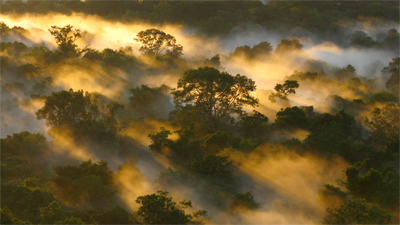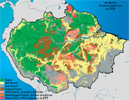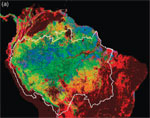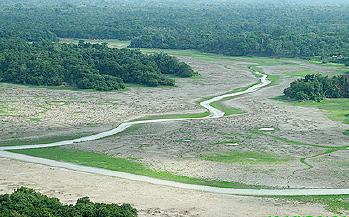Drought in the Amazon is imperiling the rainforest ecosystem and global climate, reports new research published in Science.
Analyzing the impact of the severe Amazon drought of 2005, a team of 68 researchers across 13 countries and 40 institutions found evidence that rainfall-starved tropical forests lose massive amounts of carbon due to reduced plant growth and dying trees. The 2005 drought — triggered by warming in the tropical North Atlantic rather than el Niño — resulted in a net flux of 5 billion tons of carbon dioxide (CO2) into the atmosphere — more than the combined annual emissions of Japan and Europe — relative to normal years when the Amazon is a net sink for 2 billion tons of CO2.

Misty Amazon forest canopy at dawn; Amazon water and carbon cycles are closely entwined. Image courtesy of Peter van der Steen |
The findings suggest that in the face of warming climate, relying on tropical forests as a massive carbon sink is a perilous proposition, raising questions about the effectiveness of schemes to offset industrial emissions by protecting rainforests without also curbing fossil fuel use. Should droughts worsen on a global scale, forests could become a net source of emissions, exacerbating climate change.
“For years the Amazon forest has been helping to slow down climate change. But relying on this subsidy from nature is extremely dangerous”, said lead author Oliver Phillips, referencing newly published research indicating that tropical forests have absorbed as much as a fifth of fossil fuel emissions in recent decades.
“If the earth’s carbon sinks slow or go into reverse, as our results show is possible, carbon dioxide levels will rise even faster,” Phillips, a professor at the University of Leeds, added. “Deeper cuts in emissions will be required to stabilize our climate.”
The researchers estimate that old growth forests in the Amazon store roughly 120 billion tons of carbon in their vegetation and process — through photosynthesis and respiration — 18 billion tons of carbon annually, or more than twice the emissions from fossil fuel use. Given this massive scale of carbon cycling, “relatively small changes in Amazon forest dynamics therefore have the potential to substantially affect the concentration of atmospheric CO2 and thus the rate of climate change itself,” they note.
|
Scene from the 2005 drought in the Amazon. Picture courtesy of Greenpeace. |
Overall the study found that a 100-millimeter (4 inch) increase in water deficit triggers the loss of 2.7 tons of aboveground forest carbon per hectare. However the impact of drought may be even worse — dry conditions greatly increase the risk of forest fire, including small surface fires that can inflict serious harm in even old-growth rainforest.
Drought also affects the species composition of the forest. Some species, especially fast-growing, light-wooded trees, are particularly vulnerable to reduced rainfall.
“Amazon drought kills selectively and therefore may also alter species composition, pointing to potential consequences of future drought events on the biodiversity in the Amazon region,” the authors write.
“Drought threatens biodiversity too,” said co-author Abel Monteagudo, a Peruvian botanist with the Missouri Botanical Gardens.
Unlike other research that has relied primarily on satellite imagery to measure drought stress (including one that suggested dry conditions enhance growth in the Amazon), the study was conducted under RAINFOR, a research network that monitors death rates and growth among more than 100,000 trees in 100 forest plots across the Amazon’s 600 million hectares. The granularity of the study allowed scientists to directly measure changes that would not be otherwise readily apparent but may have big impacts.
“Visually, most of the forest appeared little affected, but our records prove tree death rates accelerated. Because the region is so vast, even small ecological effects can scale-up to a large impact on the planet’s carbon cycle,” said Phillips.

|
Other research has shown that deforestation, degradation through logging, and fragmentation are accelerating the drying out of forests in the Southern Amazon. A series of studies published by Daniel Nepstad, formerly of the Woods Hole Research Institute and currently with the Gordon and Betty Moore Foundation (the world’s largest private funder of Amazon conservation), suggest that more than half the Amazon could be destroyed or degraded by 2030 should current trends of deforestation and drought hold. Presently about 18 percent of the Brazilian Amazon has been cleared.
CITATION: Phillips, O.L. (6 MARCH 2009) Drought Sensitivity of the Amazon Rainforest. SCIENCE 323: 1344-1347
RELATED
Drought and deforestation in southeast Asia linked to climate change
(12/09/2008)
Researchers have linked drought and deforestation in southeast Asia to climate change. Analyzing six years of climate and fire data from satellites, Guido van der Werf and colleagues report that burning of rainforests and peatlands in Indonesia, Malaysia, and Papua New Guinea released an average of 128 million tons of carbon (470 million tons of carbon dioxide – CO2) per year between 2000 and 2006. Fire emissions showed highly variability during the period, but were greatest in dry years, such as those that occur during El Niño events. Borneo was the largest source of fire emissions during the period, averaging 74 million tons per year, followed by Sumatra, which showed a doubling in emissions between 2000 and 2006.
Greenhouse gas emissions have already caused the Amazon to dry
(02/27/2008)
Anthropogenic emissions of greenhouse gases have already caused the Amazon to dry, finds a new study published in Philosophical Transactions of the Royal Society B.
Small fires a big threat to Amazon rainforest biodiversity
(02/27/2008)
Small fires have a big impact in the Amazon rainforest, report researchers writing in Philosophical Transactions of the Royal Society B. The findings suggest a dire future for Earth’s largest rainforest.

Half the Amazon rainforest will be lost within 20 years
(02/27/2008)
More than half the Amazon rainforest will be damaged or destroyed within 20 years if deforestation, forest fires, and climate trends continue apace, warns a study published in Philosophical Transactions of the Royal Society B. Reviewing recent trends in economic, ecological and climatic processes in Amazonia, Daniel Nepstad and colleagues forecast that 55 percent of Amazon forests will be “cleared, logged, damaged by drought, or burned” in the next 20 years. The damage will release 15-26 billion tons of carbon into the atmosphere, adding to a feedback cycle that will worsen both warming and forest degradation in the region. While the projections are bleak, the authors are hopeful that emerging trends could reduce the likelihood of a near-term die-back. These include the growing concern in commodity markets on the environmental performance of ranchers and farmers; greater investment in fire control mechanisms among owners of fire-sensitive investments; emergence of a carbon market for forest-based offsets; and the establishment of protected areas in regions where development is fast-expanding.
Amazon rainfall linked to Atlantic Ocean temperature
(02/25/2008)
Climate models increasingly forecast a dire future for the Amazon rainforest. These projections are partly based on recent research that has linked drought in the Amazon to sea surface temperatures in the tropical Atlantic. As the tropical Atlantic warms, the southern Amazon — the agricultural heartland of Brazil — may see higher temperatures and less rainfall.
Large-scale Amazon deforestation or drying would have dire global consequences
(02/21/2008)
A new study shows that large-scale degradation of the Amazon, either through drying or continued deforestation, would have global consequence, including worsening climate change, causing regional vegetation shifts, and increasing dust in the atmosphere.
Global warming – not el Nino – drove severe Amazon drought in 2005
(02/20/2008)
One of the worst droughts on record in the Amazon was caused by high temperatures in the Atlantic rather than el Nino. The research, published in Philosophical Transactions of the Royal Society B, suggests that human-driven warming is already affecting the climate of Earth’s largest rainforest.
Fire policy is key to reducing the impact of drought on the Amazon
(02/19/2008)
Gaining control over the setting of fires for land-clearing in the Amazon is key to reducing deforestation and the impact of severe drought on the region’s forests, write researchers in a paper published in Philosophical Transactions of the Royal Society B.
55% of the Amazon may be lost by 2030
(01/23/2008)
Cattle ranching, industrial soy farming, and logging are three of the leading drivers of deforestation in the Brazilian Amazon. As commodity prices continue to rise, driven by surging demand for biofuels and grain for meat production, the economic incentives for developing the Amazon increase. Already the largest exporter of beef and the second largest producer of soy – with the largest expanse of “undeveloped” but arable land of any country – Brazil is well on its way to rivaling the U.S. as the world’s agricultural superpower. The trend towards turning the Amazon into a giant breadbasket seems unstoppable. Nevertheless the decision at the U.N. climate talks in Bali to include “Reducing Emissions From Deforestation and Degradation” (REDD) in future climate treaty negotiations may preempt this fate, says Dr. Daniel Nepstad, a scientist at the Woods Hole Research Institute.

Subtle threats could ruin the Amazon rainforest
(11/07/2007)
While the mention of Amazon destruction usually conjures up images of vast stretches of felled and burned rainforest trees, cattle ranches, and vast soybean farms, some of the biggest threats to the Amazon rainforest are barely perceptible from above. Selective logging — which opens up the forest canopy and allows winds and sunlight to dry leaf litter on the forest floor — and 6-inch high “surface” fires are turning parts of the Amazon into a tinderbox, putting the world’s largest rainforest at risk of ever-more severe forest fires. At the same time, market-driven hunting is impoverishing some areas of seed dispersers and predators, making it more difficult for forests to recover. Climate change — an its forecast impacts on the Amazon basin — further looms large over the horizon.

Amazon rainforest locks up 11 years of CO2 emissions
(05/08/2007)
The amount and distribution of above ground biomass (or the amount of carbon contained in vegetation) in the Amazon basin is largely unknown, making it difficult to estimate how much carbon dioxide is produced through deforestation and how much is sequestered through forest regrowth. To address this uncertainty, a team of scientists from Caltech, the Woods Hole Institute, and INPE (Brazil’s space agency), have developed a new method to determine forest biomass using remote sensing and field plot measurements. The researchers say the work will help them better understand the role of Amazon rainforest in global climate change.








